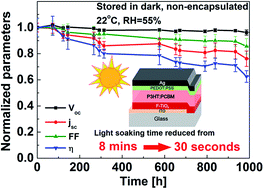Addressing the light-soaking issue in inverted organic solar cells using chemical bath deposited fluorinated TiOx electron transport layer†
Abstract
The device lifetime of an inverted organic solar cell (IOSC) is significantly better compared to standard-architecture OSC under ambient conditions. However, various studies have shown that when an n-type oxide is used as a selective electron transport layer (ETL) in the IOSC, a reversible light-soaking treatment is required. This reversible treatment largely hampers the practicality of the device, especially in outdoor applications, in which the light-soaking time may take hours every morning. In this work, fluorinated TiOx (F-TiOx), prepared by low-temperature solution-processed chemical bath deposition technique, was used as the ETL to significantly reduce the light-soaking time for a P3HT:PCBM based IOSC. Without affecting the device efficiency, more than ten-fold reduction in light-soaking time was observed for fluorinated TiOx (F-TiOx) when compared with conventional sol–gel TiOx. Ultraviolet photoelectron spectroscopy (UPS) and UV photoconductivity measurements were used to understand the light-soaking time reducing mechanism. From the perspective of ITO/TiOx interface, shift in work function was observed in F-TiOx due to the partial filling of its defective sites by fluorine atoms. Consequently, this process reduces its intrinsic trap state density compared to sol–gel TiOx even before the light-soaking treatment. As a result, the trap filling action can be completed in a shorter time upon illumination, and thus significantly reduce the duration of the necessary light-soaking.


 Please wait while we load your content...
Please wait while we load your content...